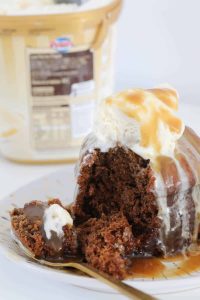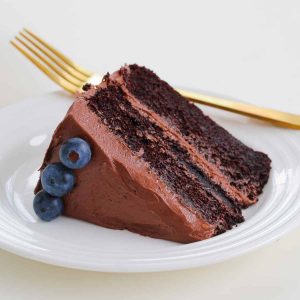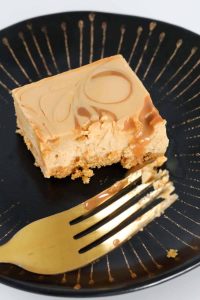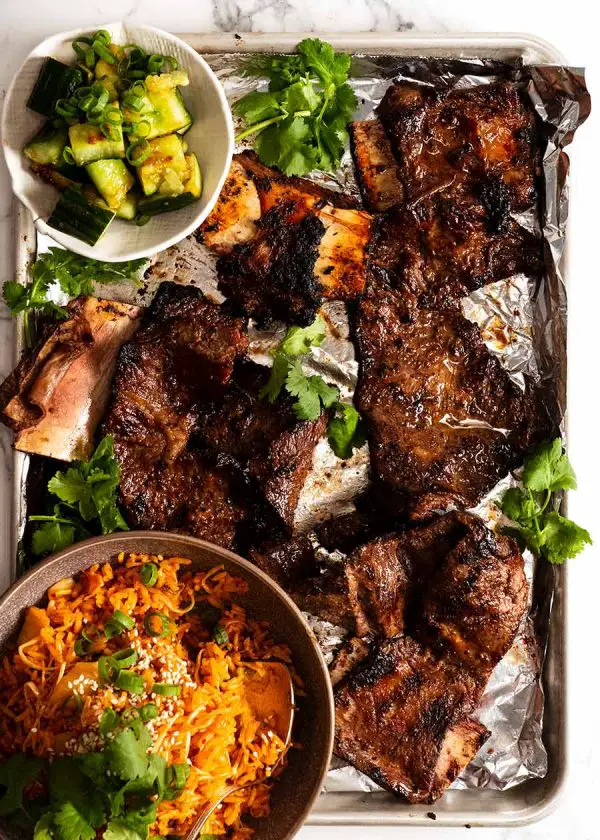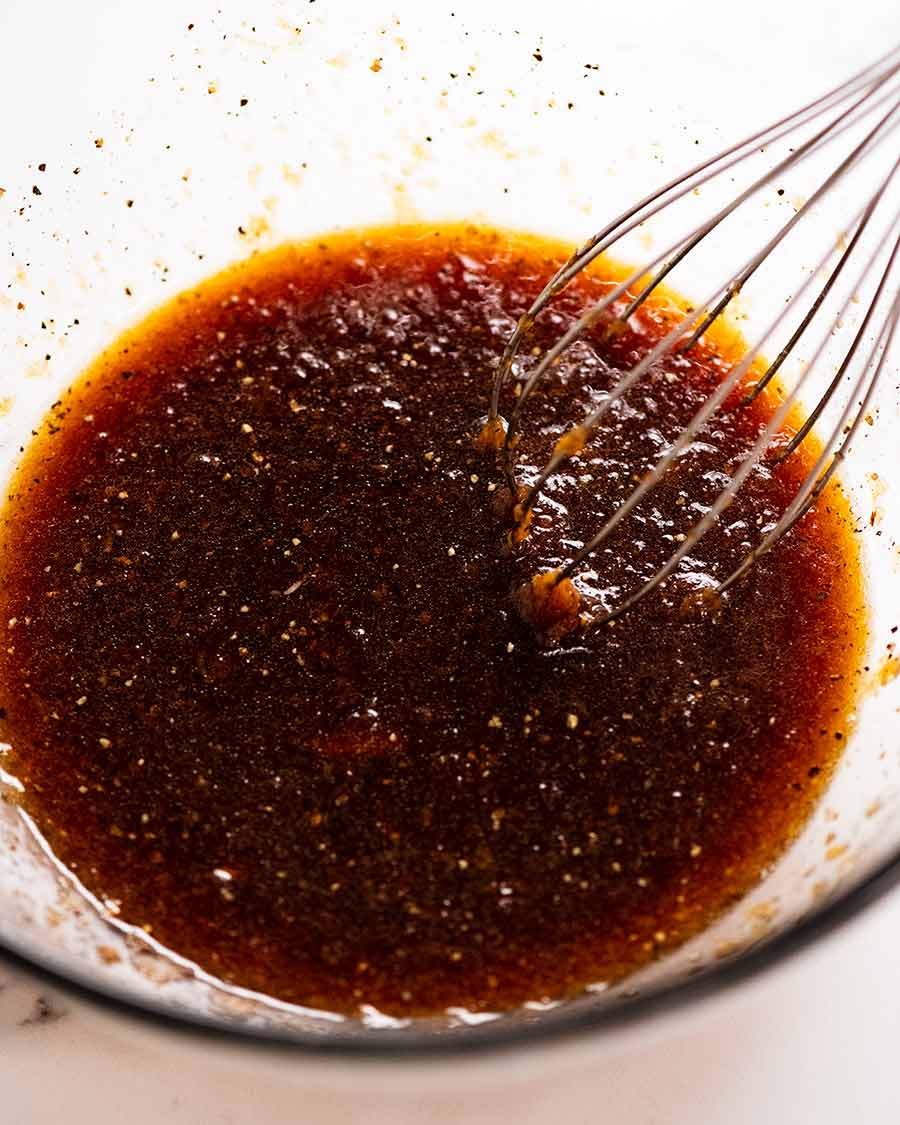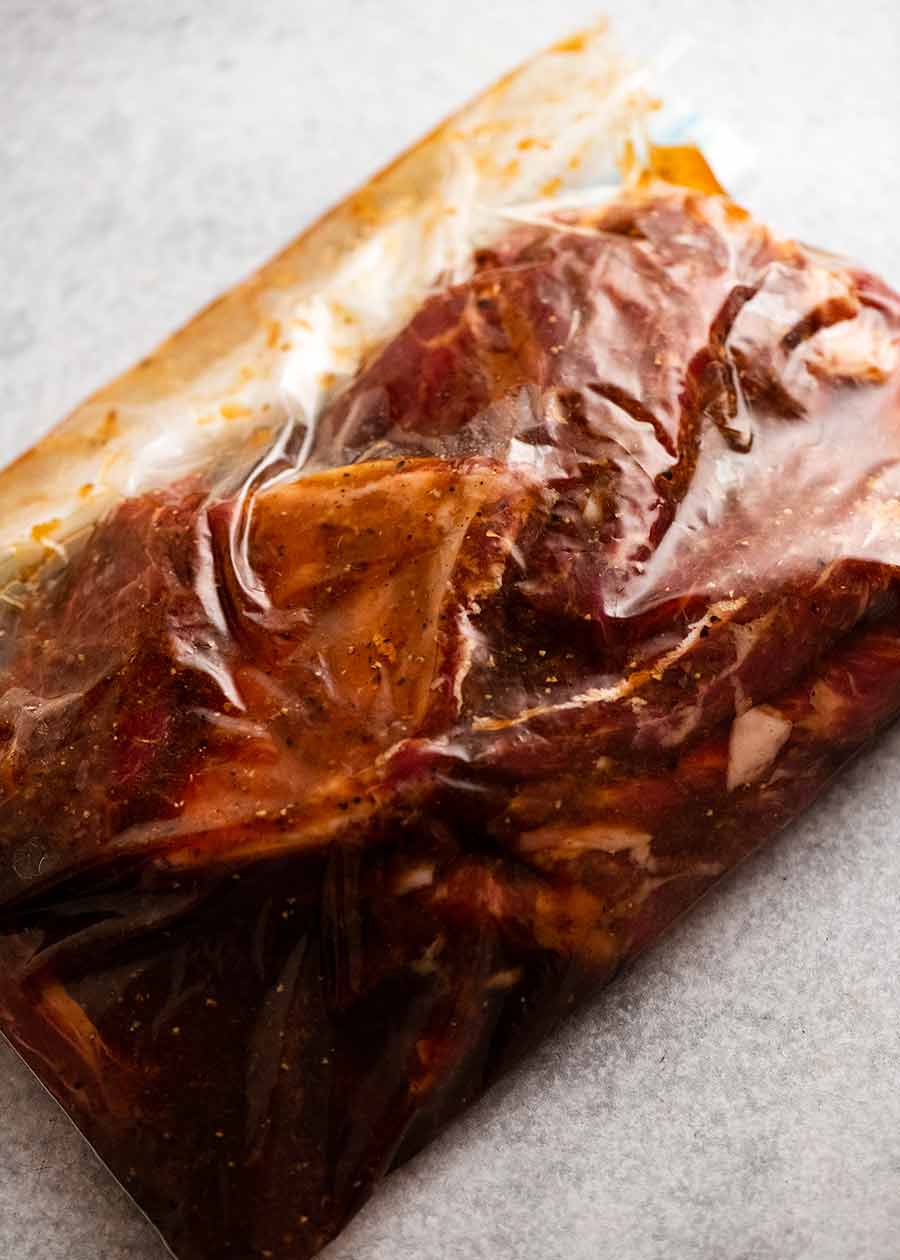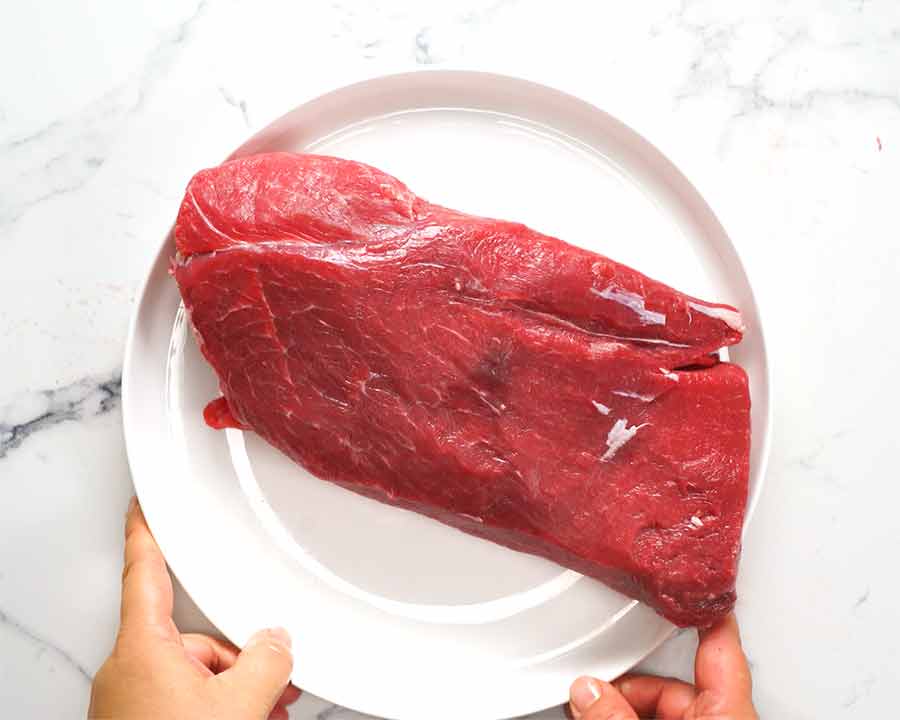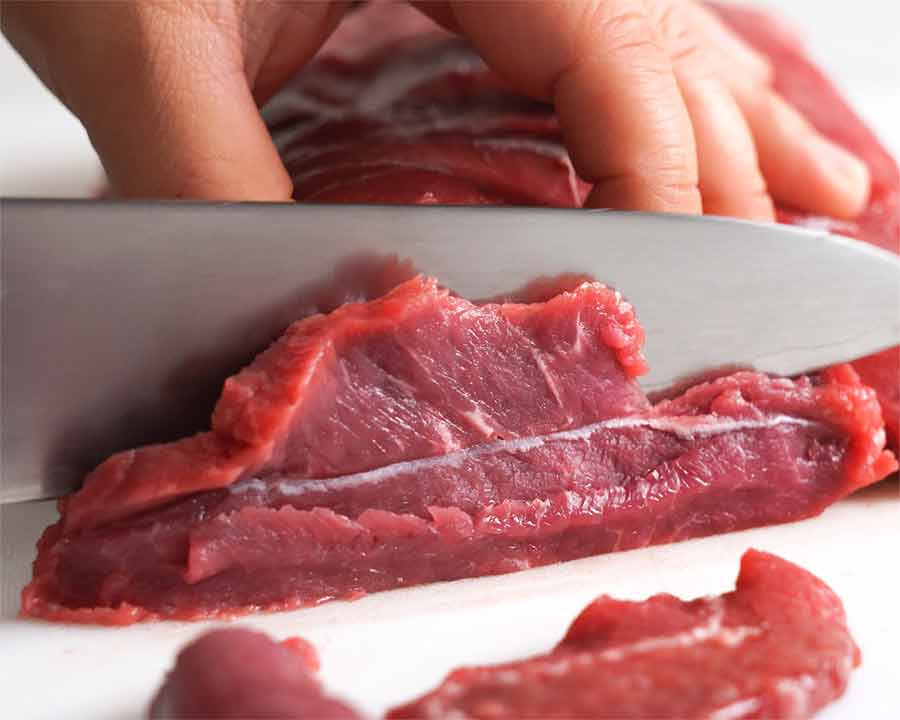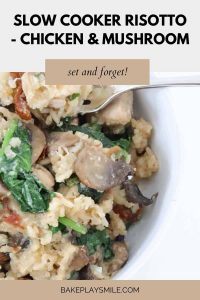This post Galbi – Korean BBQ Marinated Beef Short Ribs was updated in 2022.
The Korean BBQ’s most popular dish is the BBQ Marinated Beef Short Ribs (Galbi). The unique thing about Korean BBQ marinades – aside from their amazing flavour – is their exceptional tenderising ability which can be applied to traditionally tougher cuts such as short ribs, making them tender in a way you never thought possible.
Grilled, the tender meat will be sweet and savoury. It’s garlicky and smoky. Koreans are experts in good barbecue!
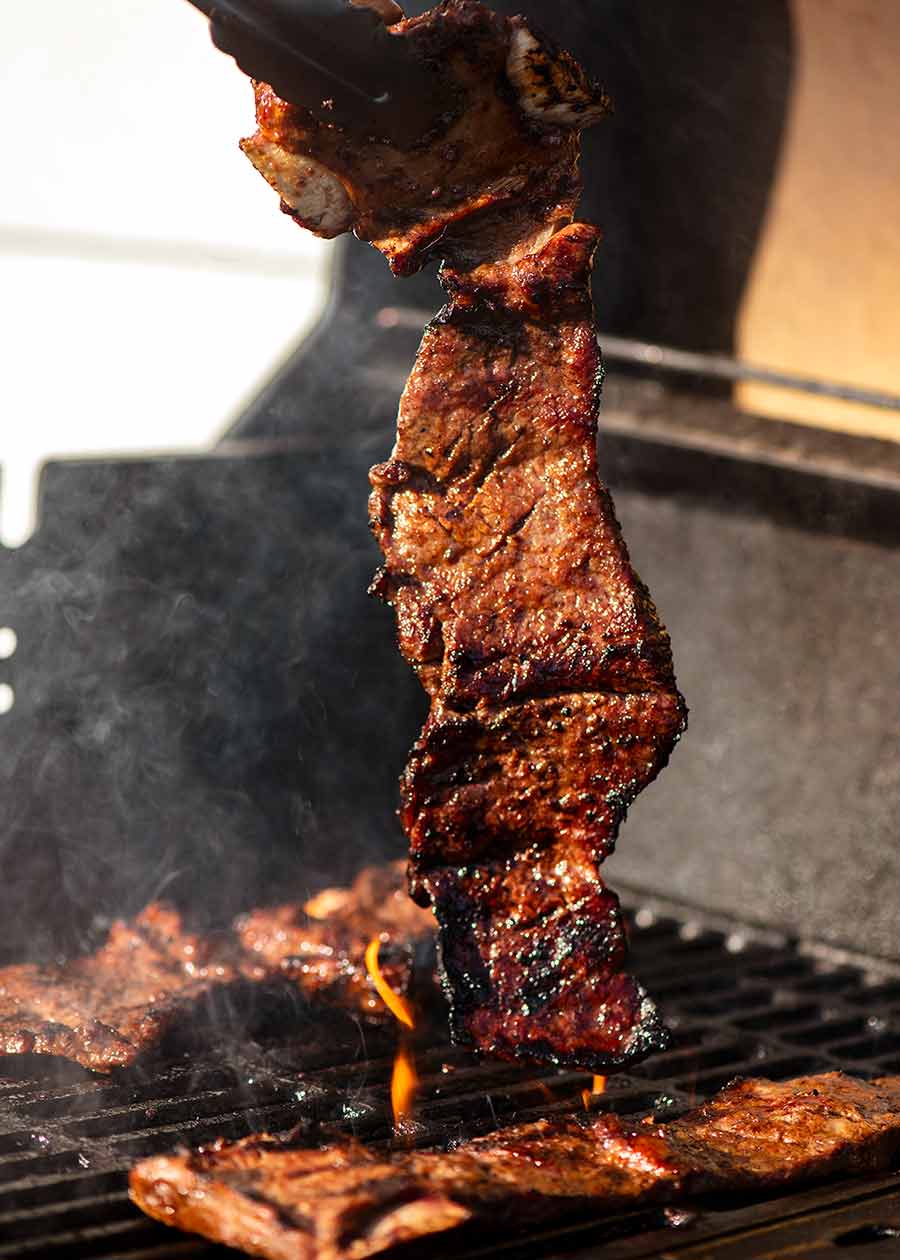
Korean BBQ Marinated Beef Short Rips
Korean barbecue is a common choice when you think of Korean cuisine. And it’s world famous for good reason! I love that it’s as much of a social event as it is an eating one, enjoyed by groups huddled around a table embedded with a grill sizzling with marinated meats, seafood and vegetables.
Interactive food is what I call it. And I’m 100% on board!
I think Korean Short Ribs is the most popular marinated barbecued meat. This cut is prized by Koreans for its rich beefy flavor. The marinade adds flavours and caramelization to the meat while it grills.
Korean Short Ribs are also notable for the unique way they are cut: The meat is “unrolled” to form a long, thin flap still attached to the bone. This ensures maximum marinade penetration, and also makes it easy to eat the meat quickly.
Koreans are masters at barbecue, as I already mentioned!
-
Korean Barbecue Marinade for Beef Short Ribs -
Marinating beef short ribs
Korean Barbecue Marinade for Beef Short Ribs
Korean barbecue marinades are a great way to make Korean BBQ delicious, despite the DIY cooking experience. There’s a few things makes Korean barbecue marinades so distinctive:
-
Extraordinary tenderising effect – Korean barbecue marinades incorporate fresh fruit such as nashi pears, regular pears, apples, kiwis and pineapples which have natural tenderising qualities. These fruits break down the fibres of otherwise tough meats, such as the short ribs we are using today, to render theme exceptionally tender – even if you happen to overcook them!
-
Unique sweet-savoury flavor – They have a familiar yet unique Asian flavours. They are often strong on garlic – much Korean food is! – leaning towards the sweet but still savoury. As some of the sweetness comes from fruit rather than sugar, it’s very different to the sugary-sweet taste of some Western sauces. They are also more complex with ingredients like grated onions, which give them a rich flavor and body.
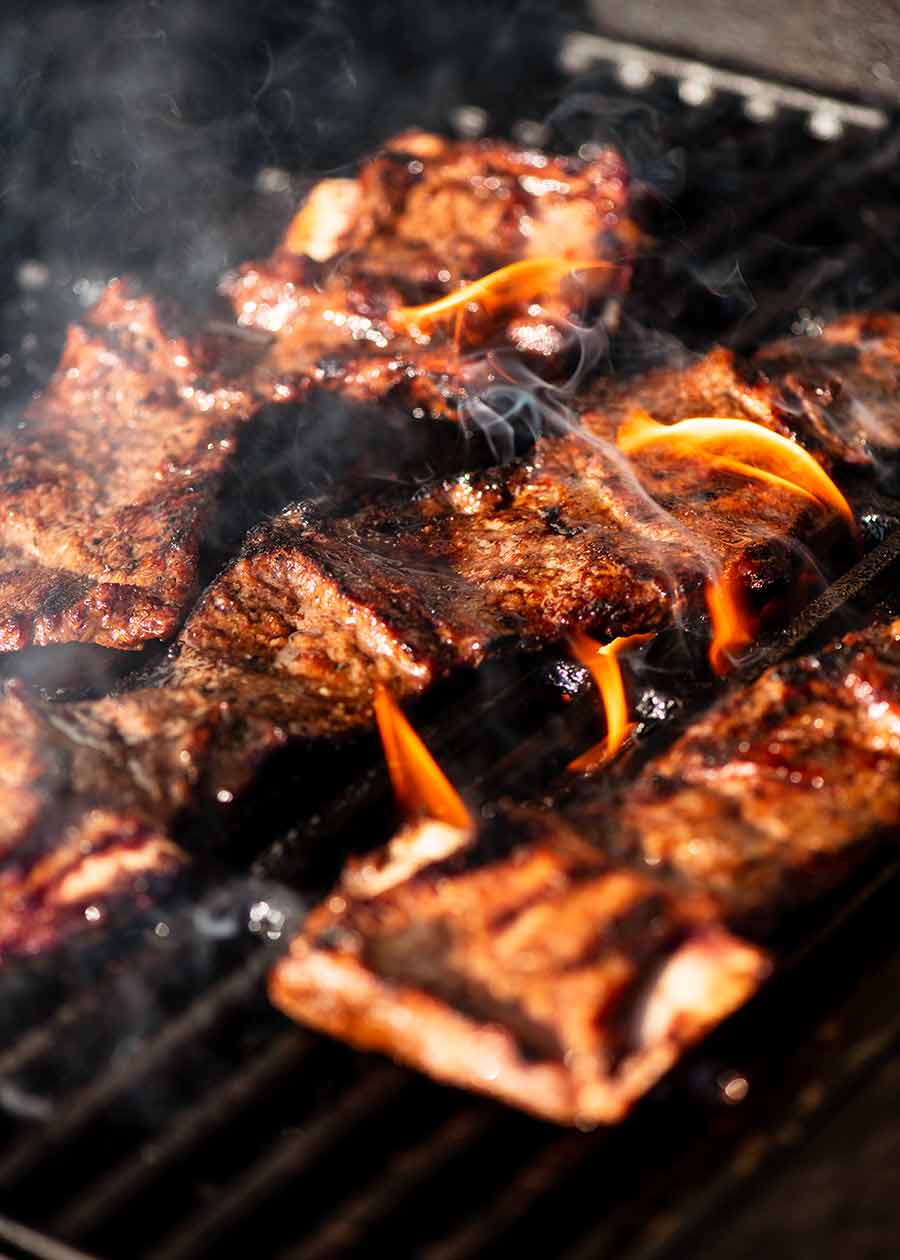
Ingredients for Korean BBQ Marinade for Beef Short Ribs
Here’s what you need for the Korean Barbecue Marinade:
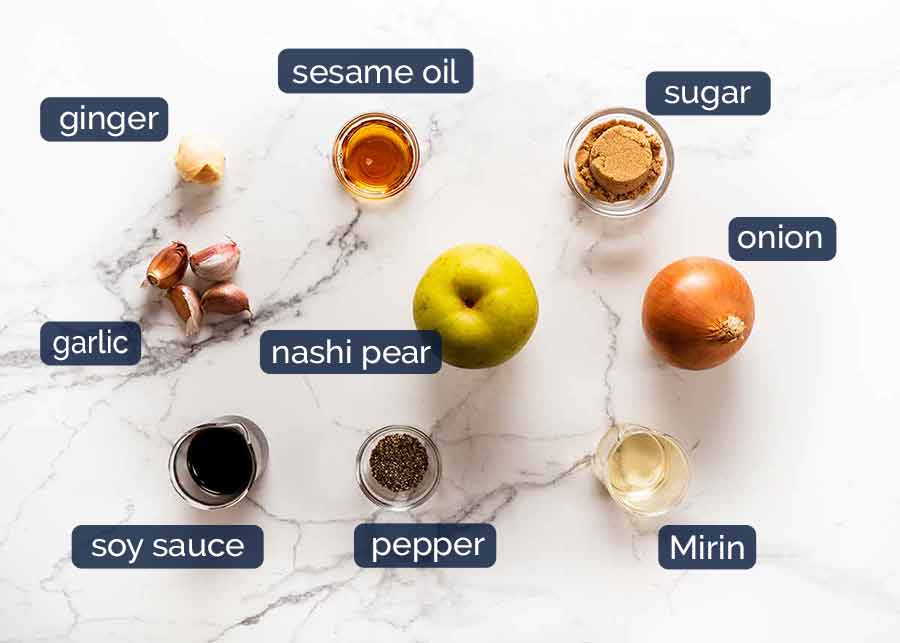
-
Nashi pear or normal pear or apple – The unique ingredient in Korean Barbecue Marinades, nashi pear and other fruits have natural tenderising qualities that can soften the fibres of even the toughest cuts of meat. Beef shortribs are slow-cooked until they become fall apart tender, as shown in this recipe and here. However, the marinade allows the meat to be barbecued thanks to its versatility.
“Nashi” is the Japanese word for “pear”. (So really, “nashi pear” means “pear pear”! 😂) It’s also known by various other names including Korean pear, Asian pear, Chinese pear, apple pear and sand pear, to name a few.
It’s shaped like a round apple rather than the distinctive pear shape, but with a flesh texture and taste similar to a crisp pear. Except – dare I say it – juicier and tastier than most pears!
Nashi pears are typically found in the autumn and winter but I have seen them often into spring.
The best substitutes: Red or normal pears. They are very similar in flavour and have the same tenderizing effect.
-
Garlic – Korean cuisine is well-known for its generous use of garlic. Korean marinades are no exception.
-
Ginger – The garlic plays a dominant role here, but ginger adds a lovely fragrant back note. Ginger is a compliment and I recommend it, but it’s not essential.
-
Onion – An essential savoury base ingredient, especially with the unique way in which it is finely grated;
-
Mirin – Japanese sweet cooking wine which adds depth and complexity into the marinade and, well, AnythingIt comes into contact with!;
-
Soy sauce – For flavour and salt;
-
Sesame oil – Like garlic, Koreans are very fond of sesame oil, and we do not complain!
-
Sugar – Adds more sweetness as well as terrific caramelisation on the beef; and
-
Black pepper – For a touch of warmth.
Korean BBQ: Beef Short Rib Cut
Beef Ribs are thick cuts of meat on the bone. They are often slow-cooked in Western cuisine to break down the fibrous fibres and become tender.
Korean BBQ uses beef short ribs. They are prepared for different cooking methods. They can be served boneless or as bite-sized, ready-to grill, pieces. Or they could be cut with the bone still attached. One of these two options is possible.
The first is known as “flanken cut” (also called LA galbiIn the USA, asadoOther parts of the world, such as Australia, have meat slices that are cut across the ribs. This allows for several small pieces of rib per piece. The other is “English cut” ribs, where there is a single, longer rib bone section per slice. In Korean butchery these are cut smaller than you’ll typically find in the shops here in Australia. Also, and perhaps most importantly, the meat is butterflied into one long, thin, beef-like piece that rolls up, while still attached to its bone.
The latter, butterflied beef short ribs, is what I’ve used today. This and the boneless cuts can be difficult to find in Western butchers. They must be purchased from Asian or Korean butchers. But don’t worry, see below for an easily accessible substitution!!
Below are photos of butterflied beef shortribs. The top photo shows how the Korean butchers sell it. It is rolled up on the bones. It is also shown unrolled in the second photo.
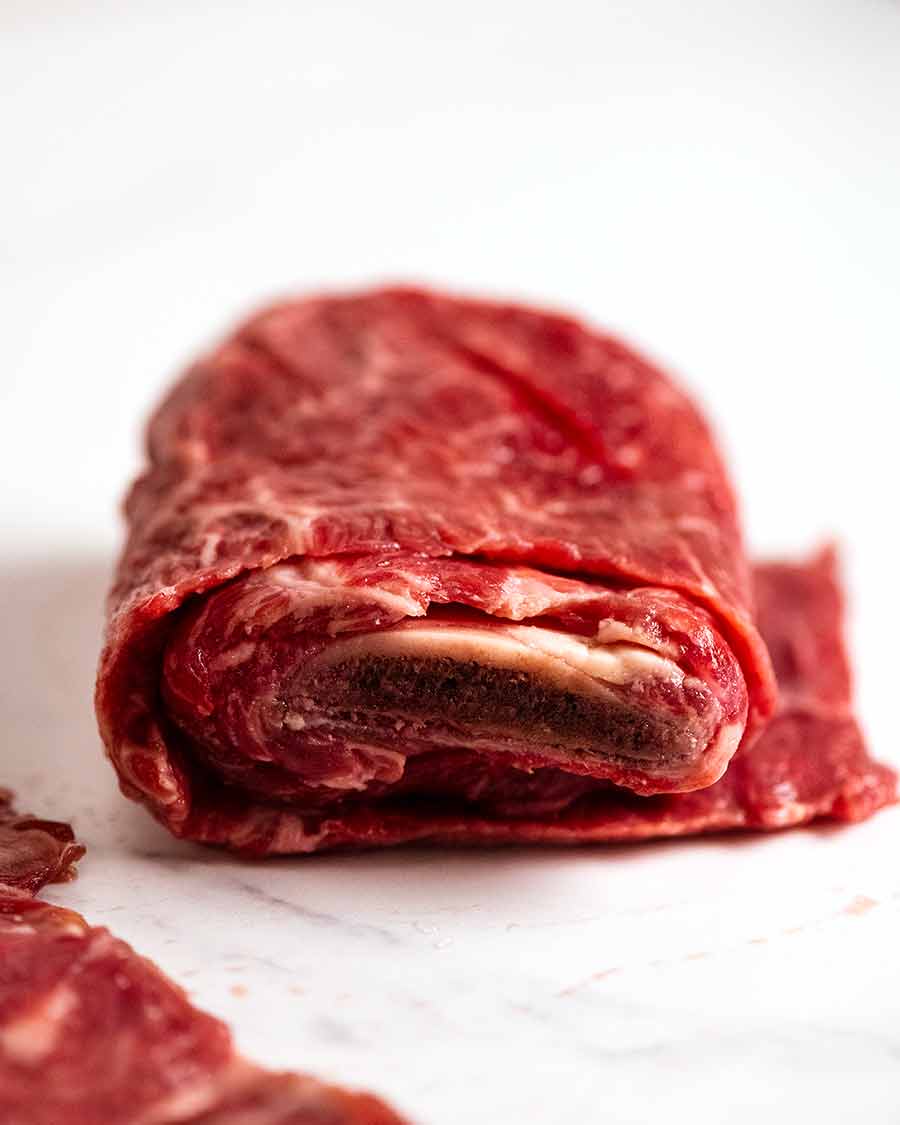
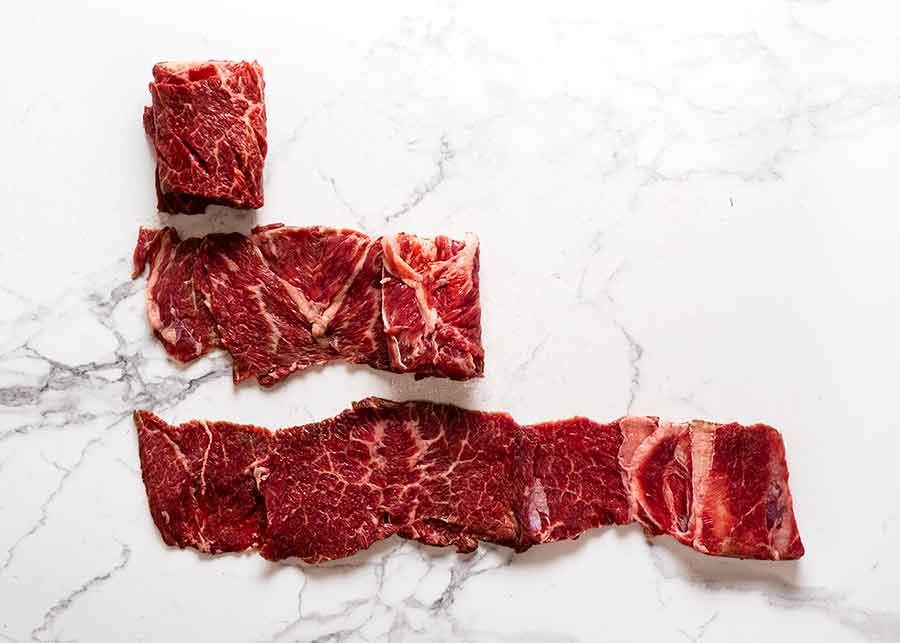
Korean short ribs cut with Korean beef: What are the best alternatives?
These are the best Korean cut beef short-ribs alternatives and options:
-
LA galbi / asado slices – As mentioned, these are also common in Korean BBQ, especially in the US. These are beef ribs that have been cut across the bone in a different manner. Make sure the LA galbi / asado slices you buy are reasonably thin (no more than 1cm / 0.5″).
-
Boneless beef ribs, sliced – This is simply short ribs without the bone; or
-
Beef oyster bladeThis is the essence of it all flatiron Steak in the USA It is similar in cooking and flavour to beef shortribs in the US.
-
It can be prepared either slowly or quickly.
-
It also has a similar beefy flavor.
-
It stays juicy and tender when it is sliced thinly and marinated with a Korean BBQ sauce. This makes the beef well-done even if it is grilled for long enough to caramelize.
-
Oyster blade is not a very well-known cut in beef in Australia. However, it can be found in large supermarkets (Coles Woolworths Harris Farms), and is considered one of the best value cuts of beef.
-
Beef oyster blade / flatiron – best substitute -
For Korean BBQ Marinade: Finely slicing Beef Oyster Blade
You can use the oyster blade by slicing it finely and substituting the beef shortribs with the recipe. If you get the oyster blade in steak form (which is how it’s typically sold at supermarkets), then slice it thinly on an angle to get pieces with a larger surface area (partially freezing it helps).
The last option is expert level! You can butterfly your own Korean beef short ribs. Sometimes it is possible to find the right sized short ribs, but they need not be butterflied. You can butterfly your own if you’re confident. You can do it if you have the skills and patience to take your time. Pieces with ribs approximately the same size as those in my photos are required. ~8cm / 3″ long. This post does not cover the cutting process. Instead, you can follow this helpful tutorial by Modern Pepper (a Korean website that teaches cooking).
How to make Korean BBQ Beef Short Ribs
One of the most distinctive techniques in Korean marinades involves the fine grating of onion and fruit (nashipear, in this example) to maximize the flavour and effect of the marinade.
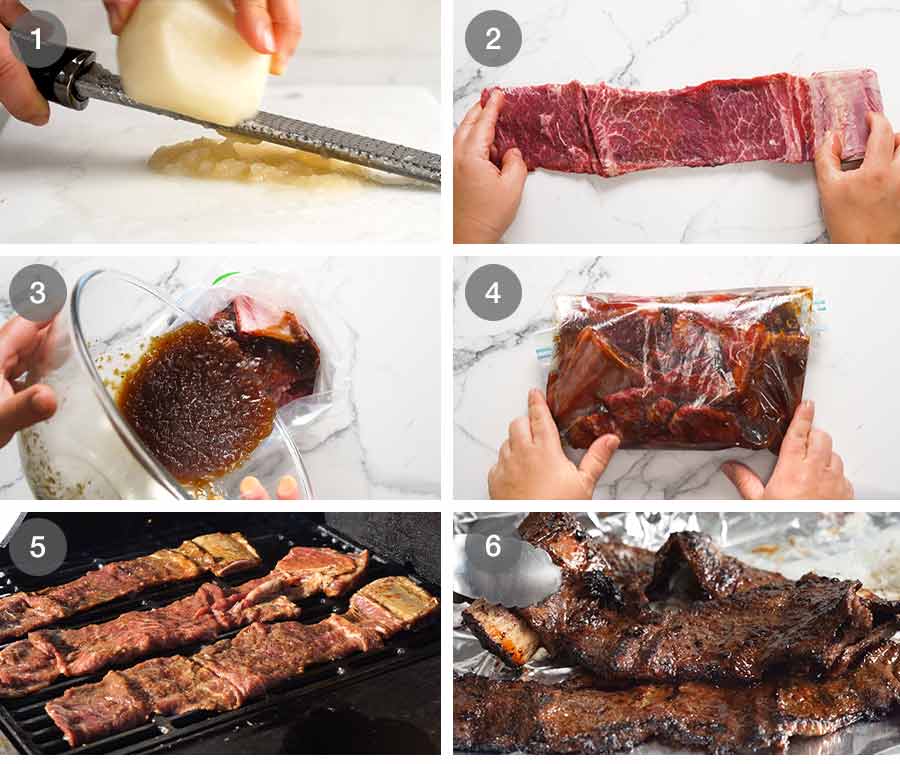
-
Finely gratedMix together the garlic, ginger, nashi pear and ginger with the rest of your marinade ingredients.
-
UnrollThe Korean cut butterflied beef short-ribs;
-
Add the marinade to a baggie or container that can hold beef.
-
MarinateFor 24 hours, beef Don’t shortcut this – beef short ribs are a tough cut of beef so it needs the full marinating time to ensure it is properly tenderised;
-
Cook Meat should be cooked on a BBQ, but you can also use a stove. I like to use my BBQ so I can cook the beef strips whole – because it looks so good! When indoors, practicality rules so you can cut them into pieces that fit in your pan or skillet.
It takes around 2 – 3 minutes on a hot BBQ to caramelise each side, by which time the inside of the thin slices of beef are very, very well done – in fact, technically overcooked for meat this thin. But Don’t worry! This is intentional! Why? Because it keeps it tender. In fact, I’ve cooked it for well over 10 minutes and it was still unbelievably tender.
Seriously. This Korean marinade works like magic.
-
Take outeThen heat on the stove or BBQ. This Korean barbecue beef is un-marinated and does not require a sauce.
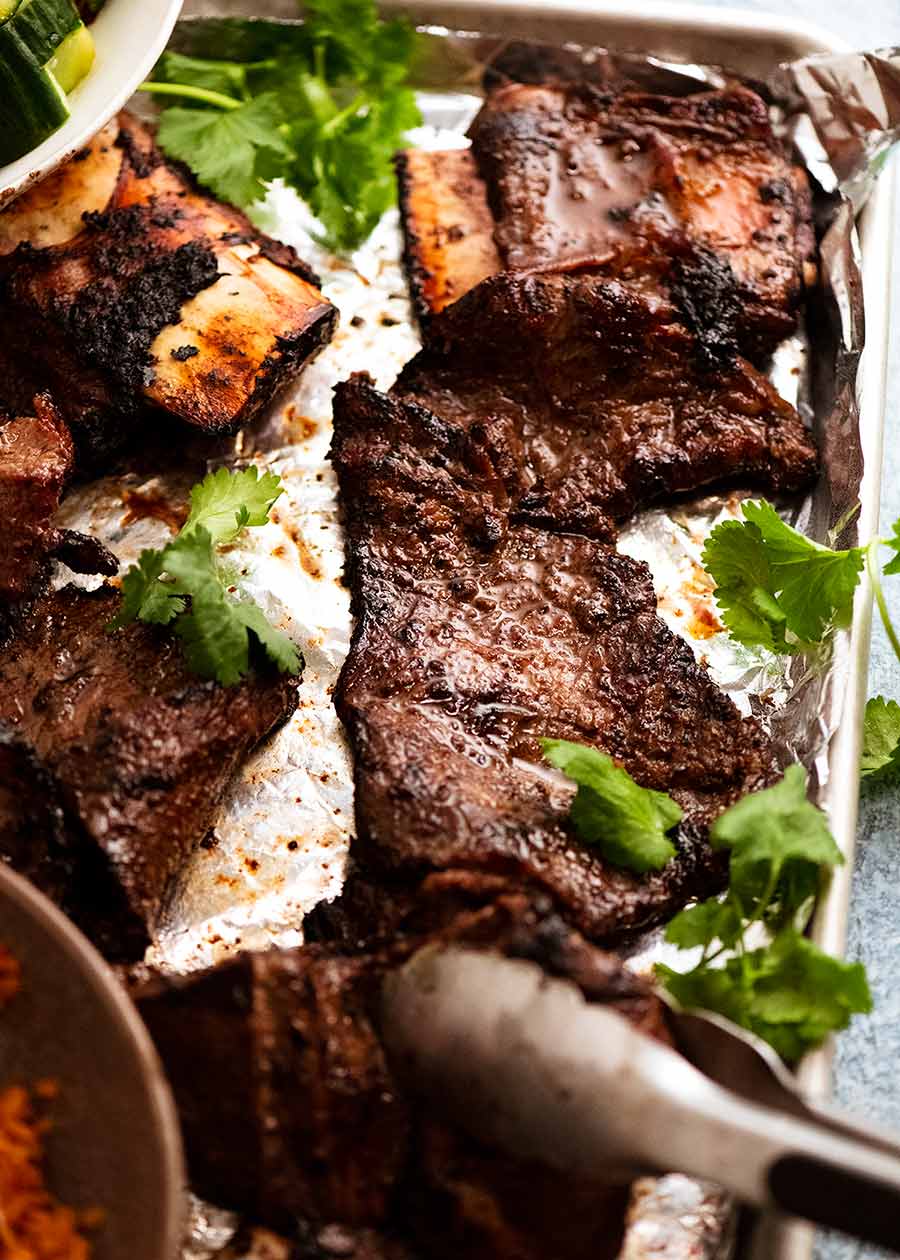
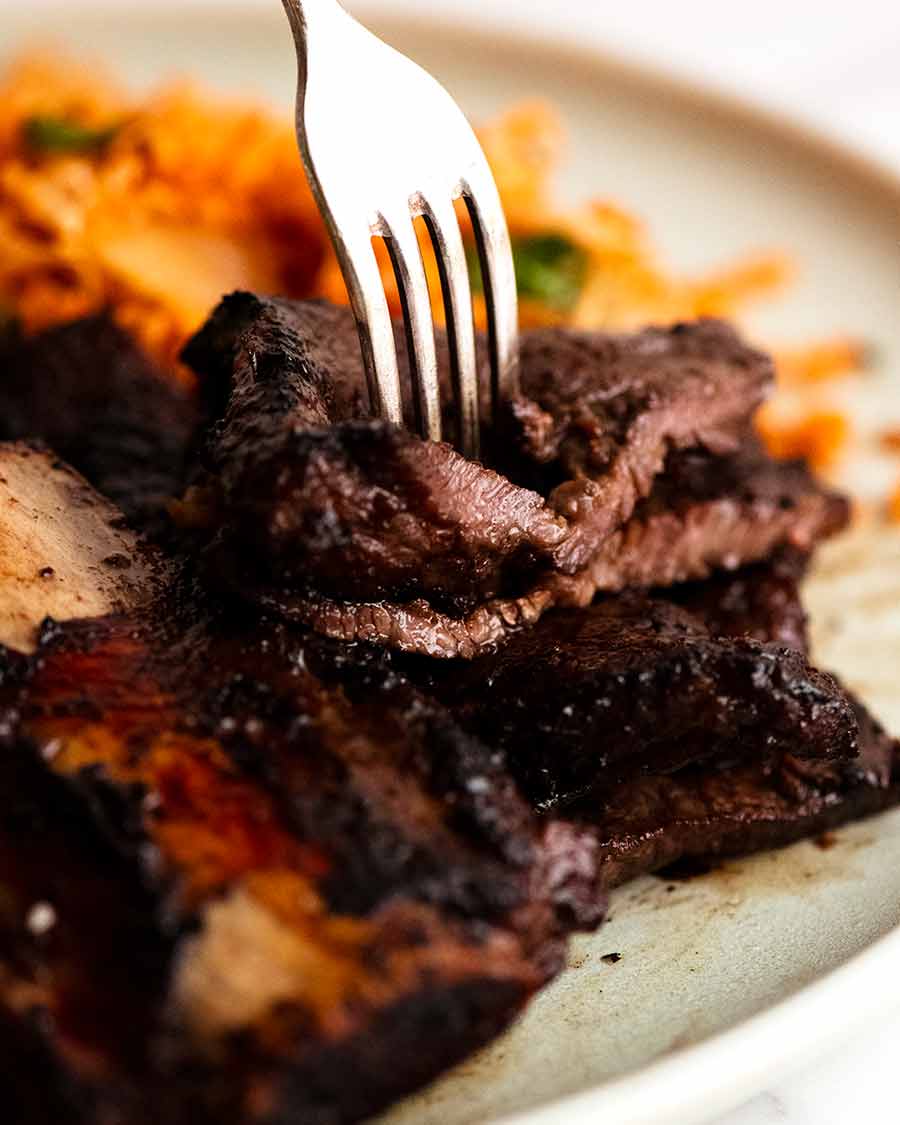
Korean Marinated BBQ Beef Shortribs: What should you serve?
Korean cuisine is also well-known for its variety of simple, delicious, and largely vegetable side dishes. banchanThese are served alongside the main course. You can count on a small number of people in your home, or up to twelve in restaurants. There are so many sides that each dish is served separately on every surface of the table.
You must have kimchi, whether it is homemade or purchased. Potato salad almost always appears. Some kind of simple lettuce salad – say, lettuce, some canned corn kernels, thinly sliced onion – is also typical (my Asian sesame dressing would be perfect here!) Stir-fried vegetables are also great as an accompaniment to Korean mains. Any of the individual vegetable dishes in my bibimbap can also be used as mini-banchan.
Meanwhile I can also offer up some other very typical Korean banchan recipes I’ve used from other websites:
-
Bean sprout or soybean sprout salad – from the loveable Maangchi!
-
Pickled radishes (easy) – from My Korean Kitchen (one of my go-to sources of authentic Korean recipes); and
-
Korean Sesame Spinach Salad (easy) – also from My Korean Kitchen
-
Sweet Soy Potatoes – from DriveMeHungry
Kimchi Fried Rice (both my recipes), and Ginger Smashed Cucumbers are featured in this post. They are delicious with the juicy Korean beef. I love the fiery red color of the fried Rice, which is much more intense in taste than it looks.
Here are some more options:
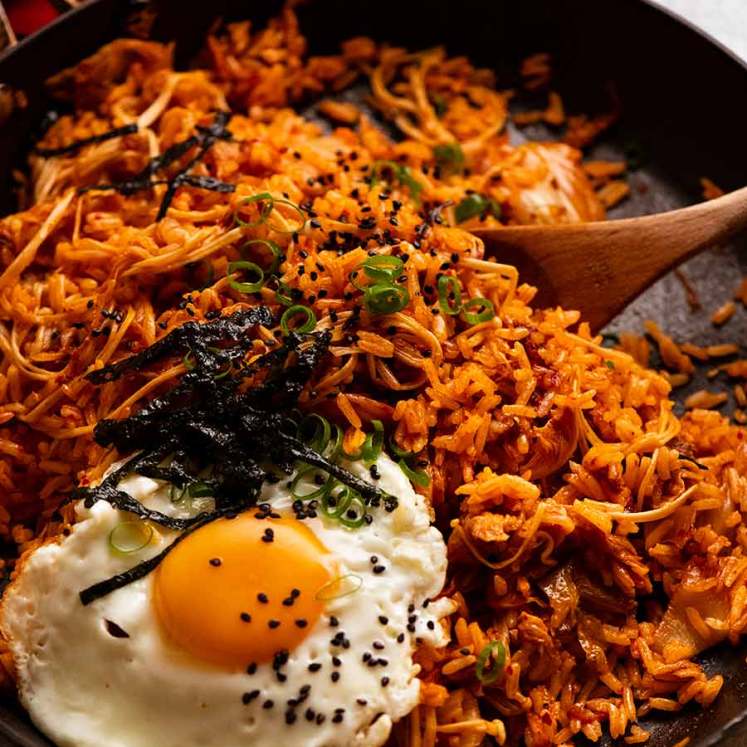
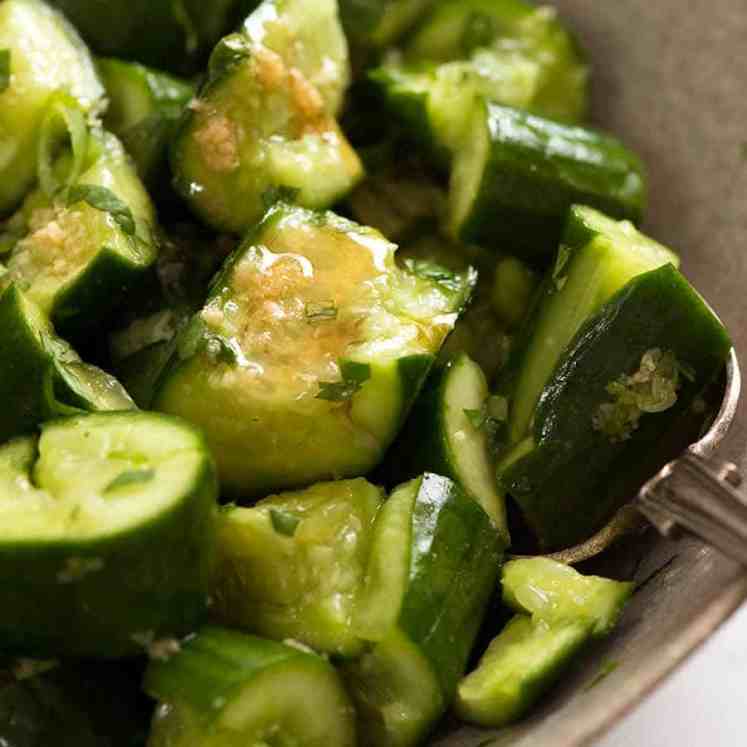
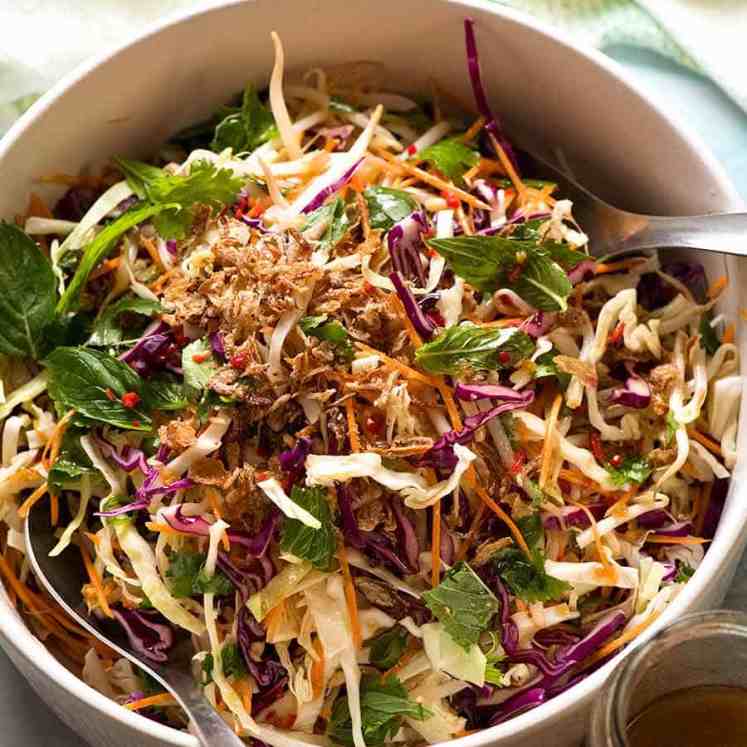
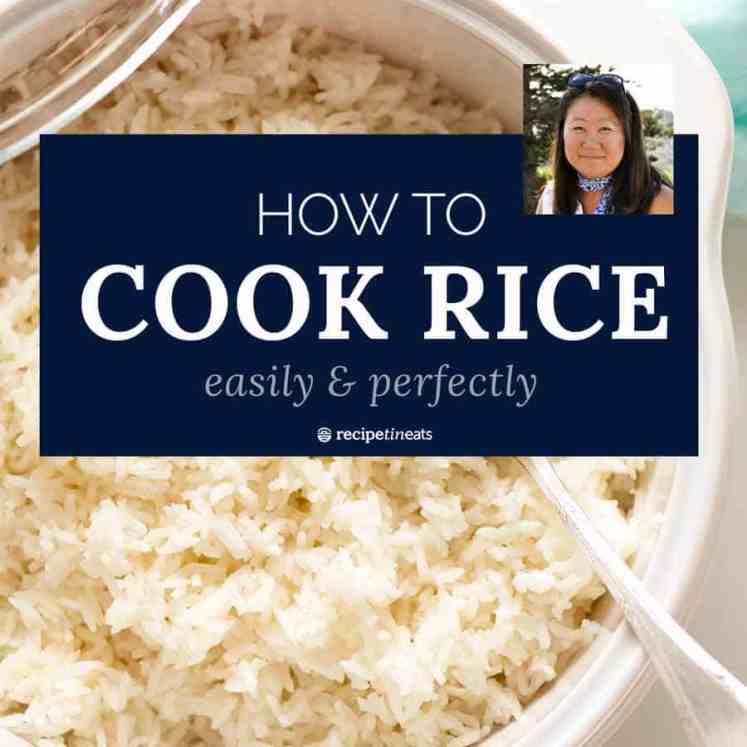

Happy Korean cuisine! – Nagi x
How to make it
Are you hungry for more?For the most up-to-date information, subscribe to my newsletter. Follow me on Facebook and Instagram.
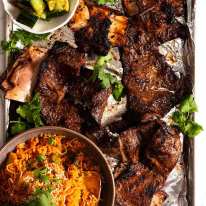
Galbi – Korean BBQ Marinated Beef Short Ribs
The marinade will not cause the thin slices to become tough. The marinade is magic. It will keep the thin slices of beef tender even when you cook it for longer than 10 minutes.
Ingredients
- 1 kg/ 2lb Butterflied Korean beef short ribs (pictured) or thinly sliced through bone (Note 1 – subs)
- 1 tbsp Vegetable oil For cooking
Korean Barbecue Marinade:
- 1/3 Cup soy sauce (All purpose or light soy, but not dark or sweet).
- 1/4 Cup brown sugar
- 2 tbsp mirin (Note 2)
- 1/4 Cup Onion Finely grated (including juice).
- 1/4 Cup nashi pear Finely grated with juice (subnormal pear, any red apple, Note 3)
- 2 tsp garlic Finely grated
- 2 tsp ginger Finely grated
- 2 tbsp Water
- 1 tbsp toasted sesame oil (Note 4)
- 1 tsp black pepper
Serving (optional).
- Green onion, sesame seeds, coriander/cilantro leaves For garnish
- Kimchi Fried Rice
- Mash Cucumbers
Instructions
-
Marinade Mix all ingredients of the Marinade in a bowl.
-
Marinade 24 Hours Place beef in a plastic bag, glass, or ceramic container. Add Marinade to beef. Mix well. Marinate for 24 hours in a covered container.
Cooking:
-
Marinade can be removed from beef, and Marinade must be thrown away.
-
Barbecue – Heat on high until smoking hot, then brush grills with vegetable oil. Grill the beef and cook on each side for 2 minutes until it is caramelized. Turn the steak and cook until caramelised on the other side. Cover the other side with foil and let cool.
-
Stove – Cut beef strips into pieces that will fit your skillet. Oil skillet on high heat. Place beef in skillet and cook 2 minutes or until golden brown. Then turn the heat off and cook the second side for 2 additional minutes.
Serving:
-
If desired, garnish beef with sesame seeds or green onions. You don’t need a sauce for this one – it is literally dripping with flavour! Pictured with Kimchi Fried rice and Ginger Smashed Cucumbers.
Recipe Notes
Special equipment is required to cut through the bone. Butterflying short ribs also requires nifty knife skills. Beef ribs are not as fat as Western ones and are meant to be slow braised until they are meltingly tender (such a Red Wine Sauce or BBQ Sauce).
I prefer to get my meat pre-cut at Korean butchers. I go to Hahn’s Quality Korean Meats in Eastwood (Sydney) which is a Korean neighbourhood. Many Asian butchers also sell Korean cut beef ribs.
The best substitutions:
a) Short ribs without bones, sliced;
b) Beef oyster knife, which is the equivalent of flatiron steak in the US. It is similar in cooking properties (can be slow or fast cooked), and has a similar texture + beefy flavor. Best to buy it in a roast form then slice 0.5cm / 0.2″ thick, marinade and cook per recipe. Oyster steaks can be purchased at major grocery stores in Australia (Woolies Coles Harris). These can be frozen for one hour to make it easier to cut. Then, slice along the diagonal across the surface to get thinner slices.
2. Mirin – Japanese sweet cooking sake is a great choice! It adds complexity and depth to all things it touches. The best substitute is 1 tbsp Chinese wine (Shaoxing) or cooking sake. If it is not, you can leave it out.
3. Nashi Pear – It is highly prized for its natural tenderizing properties for tough cuts of beef and sweet flavour. You can substitute it with any other type of red apple or normal pear.
4. Sesame Oil – Toasty sesame oils are browner and have more flavour than untoasted oil (which is yellow). Sesame oil in Australia comes standard with a toasted flavor. Untoasted oils are more difficult to find.
5. Storage – marinated beef can be put in the freezer immediately, then it will marinate as it thaws overnight in the fridge. Cooked beef will keep for 4 – 5 days, but it’s truly at its best freshly cooked!
6. NutritionAssumes that all of the marinade has been consumed. This makes it impossible to calculate the calories per serving, but sufficed to say it is much lower.
Nutrition Information:
The Spicy Side of Korean Life
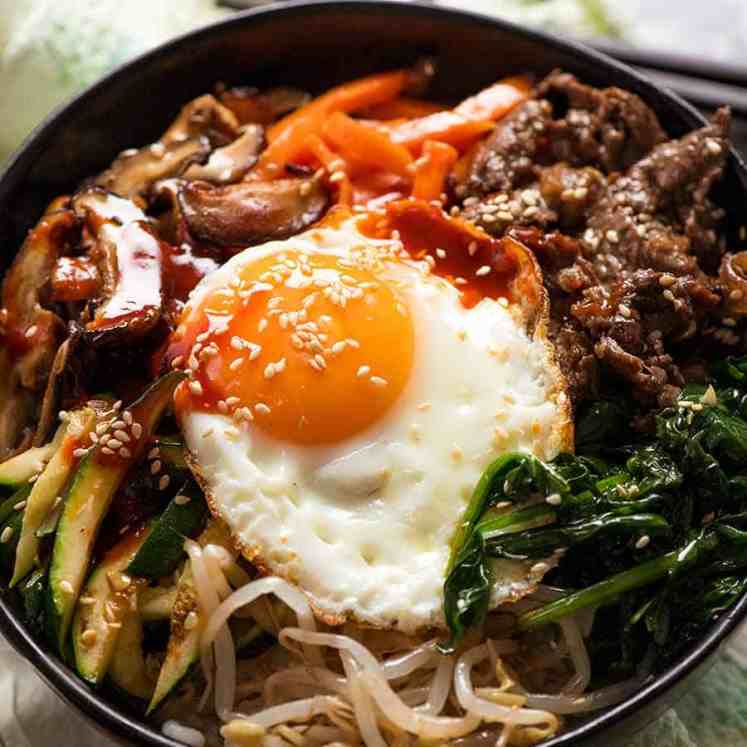
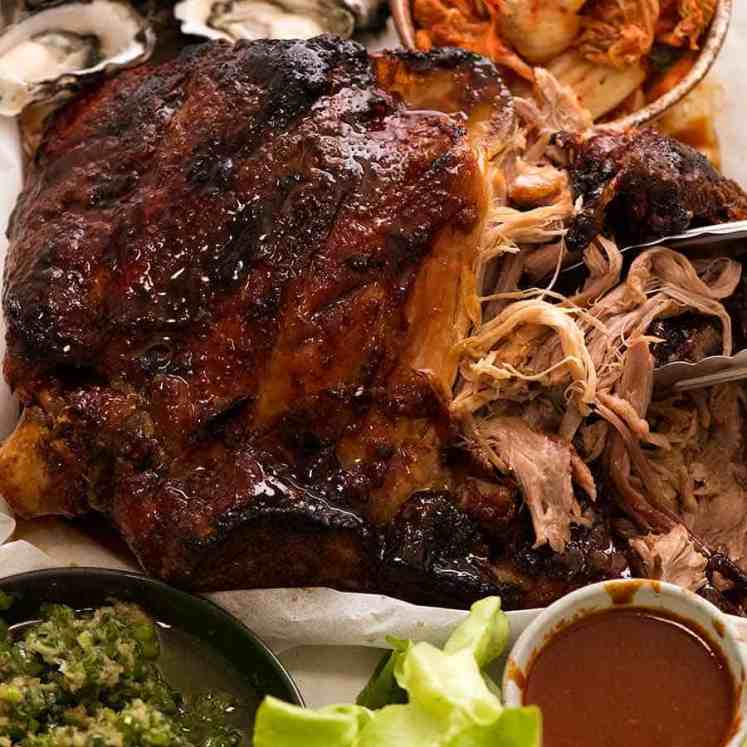

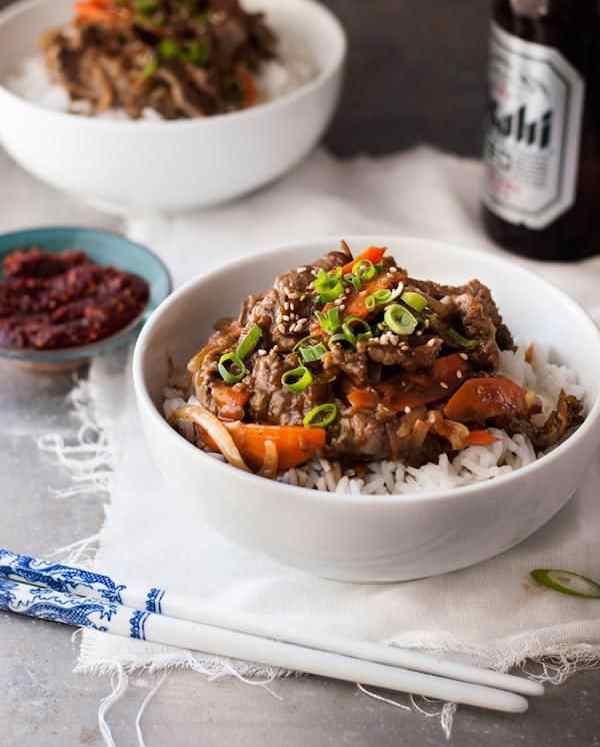
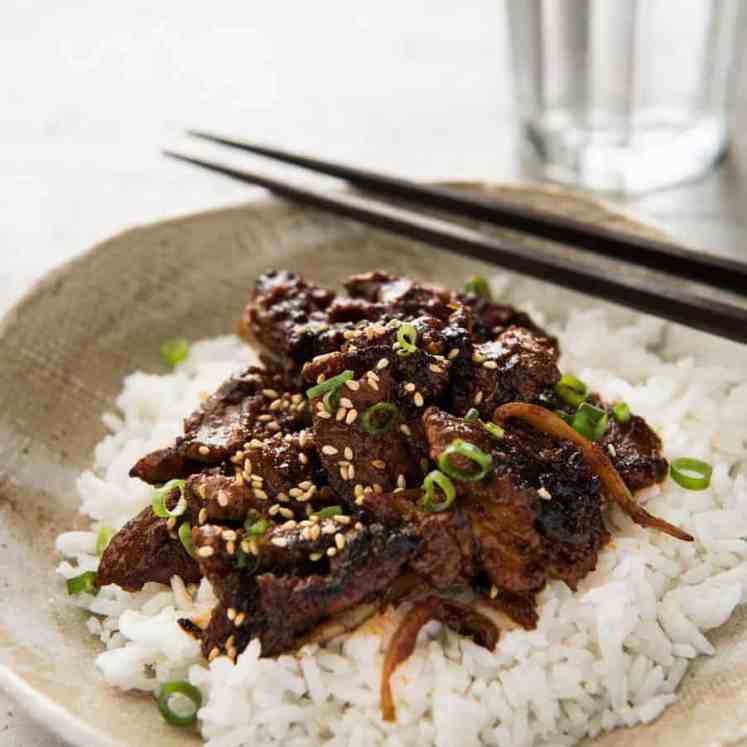
Dozer Life
Dozer in Tasmania, when I cheat on him! 💔Oscar, a trail dog owned by a friend who can actually keep up with mountain biking trails. Dozer, however, isn’t a long-distance runner and so he stayed at home. This is in Derby, Tasmania – just got back last night!
Here’s Dozer and me, reunited. He knows I’ll always be faithful to him…..!!


